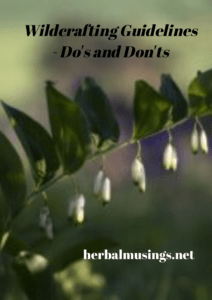Wildcrafting for your herbal medicines and foraging for food are wonderful experiences to get to know the plants on many levels. You learn where and how they grow, under what conditions and whether or not you are allowed to harvest them.
As you commune with these plants, you will ‘know’ if you are allowed to harvest some of their leaves, flowers or roots. The plants communicate with you on a deep level. Always ask permission from the plant if you can harvest any part of it; if the plant says no respect that and move on. Why? That particular plant could have had a hard start in the spring growing and needs all of its leaves and roots to help it survive.
In our modern age, many people are disconnected from nature, their food and the rhythms of nature. It’s time we get back to nature and her cycles, the plants, and our wild food.
Wildcrafting Responsibly
If you’re going to harvest wild plants, do so in a way that proliferates their population rather than depleting it. This includes a variety of practices, meaning some years you don’t harvest from a particular patch or population. This might be because of drought, disease, pests or any other situation that threatens a plant’s population. Wildcrafting also means learning the At-Risk and To-Watch lists of plants from United Plant Savers. Also, pay attention to any local threatened plants and ecosystems.
When harvesting, you take a few plants here and a little there. The area should show very little harvesting. This leaves enough for the animals, pollinators, and germinating seedlings.
Please don’t over harvest. Be considerate of the land from which you are gathering. Consider the land from the perspective of the animals living there, from the humans who visit, and from the perspective of the plants themselves in their ecological niche. Overharvesting plants damages this ecosystem, and sometimes it takes years to recover.
Other Ways To Help Wild Plants
Something to consider when you are out wildcrafting is gathering seeds and replanting them in a habitat similar to the one you found them in. This ensures the plant species will survive and propagate.
Rescue plants from areas that are going to be developed or destroyed. Besides gathering these plants as medicine, you also help relocate the less common ones to similar habitats and gardens. Many plant species have been saved from being wiped out completely by relocating them.
While gathering roots and rhizomes, replant root crowns and rhizome pieces, especially if there is a bud present to help the plant re-grow.
Most important in my opinion is learning how to make accurate plant identifications. It is very important to know how to accurately identify plants and species. Books with detailed descriptions and pictures are very important to take with you in the field. A knowledgable person to assist you in the field with plant identification is invaluable, it is the best hands-on learning tool.
This post may contain affiliate/referral links. Read my full Disclosure/Disclaimer Policy.
